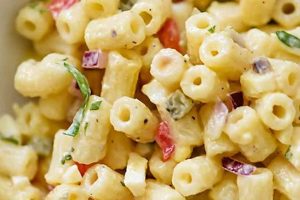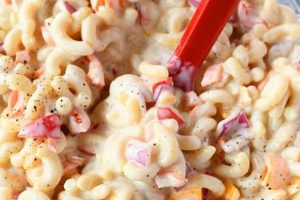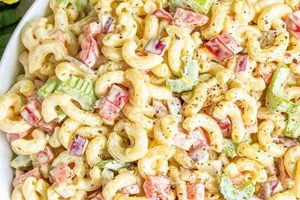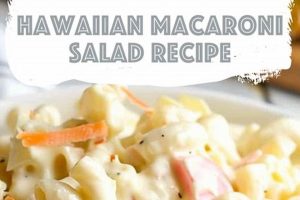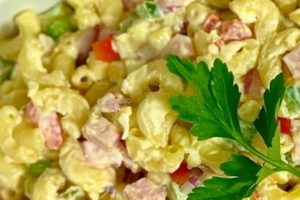This classic dish typically combines cooked elbow macaroni, diced ham, and cubed cheese, often cheddar, in a creamy dressing. Variations may include additional ingredients such as vegetables (peas, celery, onions), hard-boiled eggs, or different cheeses. The dressing often features mayonnaise, sometimes blended with sour cream or yogurt, and is seasoned with mustard, vinegar, salt, and pepper.
A versatile and convenient food, this type of salad serves well as a side dish at picnics, barbecues, and potlucks, or as a light main course. Its adaptability to different ingredients allows for customization to suit various tastes and dietary needs. The combination of carbohydrates, protein, and fats offers a satisfying and relatively balanced meal option. Its historical roots likely stem from the increasing popularity of convenience foods in the mid-20th century, with macaroni salads becoming a staple of American cuisine.
Further exploration will cover variations on this dish, tips for achieving the perfect texture and flavor, nutritional information, and suggestions for serving and storage.
Tips for a Superior Macaroni Salad
Achieving optimal flavor and texture requires attention to detail. The following tips will guide preparation of a successful and satisfying dish.
Tip 1: Cook Macaroni Properly: Cook pasta al dente for optimal texture. Overcooked macaroni results in a mushy salad. Rinse cooked pasta under cold water to stop the cooking process and maintain firmness.
Tip 2: Choose Quality Ingredients: Select high-quality ham and cheese for superior flavor. Consider using freshly grated cheese rather than pre-shredded varieties.
Tip 3: Balance the Dressing: The dressing should complement the other ingredients, not overpower them. Adjust seasonings to achieve a balanced flavor profile. Start with a small amount of mayonnaise and add more as needed to achieve the desired consistency.
Tip 4: Enhance with Fresh Ingredients: Incorporating chopped celery, red onion, or bell pepper adds texture and complexity. Fresh herbs such as dill or chives can also enhance the flavor.
Tip 5: Chill Thoroughly: Allow the salad to chill in the refrigerator for at least two hours before serving. Chilling allows the flavors to meld and enhances the overall taste.
Tip 6: Consider Textural Variety: Add chopped hard-boiled eggs or crumbled bacon for additional protein and textural contrast.
Tip 7: Drain Ingredients Well: Ensure all ingredients, including chopped vegetables, are well-drained to prevent a watery salad.
By following these tips, one can create a macaroni salad that is both flavorful and visually appealing. Attention to these details ensures a satisfying culinary experience.
With these preparatory steps addressed, the subsequent sections will delve into specific recipe variations and address common queries.
1. Ingredients
Ingredient selection significantly impacts the final quality and flavor profile of macaroni ham and cheese salad. Careful consideration of each component ensures a balanced and enjoyable dish. The following facets highlight key ingredient categories and their contributions.
- Macaroni
Elbow macaroni is the traditional choice due to its shape and ability to hold the dressing. Alternative pasta shapes, such as shells or rotini, can be used, but may affect the overall texture and aesthetic. High-quality pasta made from durum wheat offers superior texture and flavor compared to lower-quality alternatives.
- Ham
Ham provides a savory, salty element. Options include pre-cubed ham, sliced ham diced by hand, or higher-quality ham from a deli counter. The ham’s quality directly influences the overall flavor; using a smoked or honey-cured ham can add depth and complexity.
- Cheese
Cheddar cheese is a popular choice for its sharpness and melting properties. Other cheeses, such as Colby, Monterey Jack, or Swiss, offer different flavor profiles and textures. Sharp cheddar provides a robust flavor, while milder cheeses offer a creamier texture and subtler taste. Grating cheese from a block generally results in better melting and a fresher flavor than pre-shredded options.
- Dressing
The dressing binds the ingredients and contributes significantly to the overall flavor. Traditional dressings often incorporate mayonnaise, mustard, and seasonings. Variations can include sour cream, yogurt, or vinegar for added tang and complexity. The balance of creamy and acidic components in the dressing determines the final taste and texture of the salad.
The interplay of these key ingredients determines the overall character of the macaroni ham and cheese salad. Balancing flavors and textures through careful ingredient selection is essential for creating a successful dish. Utilizing high-quality ingredients enhances the flavor profile and elevates the overall dining experience.
2. Preparation
Proper preparation is crucial for a successful macaroni ham and cheese salad. Careful execution of each step ensures optimal texture, flavor, and food safety. The following facets highlight essential preparatory steps:
- Cooking the Macaroni
Cooking the pasta correctly is foundational. Macaroni should be cooked al dente, meaning firm to the bite. Overcooking results in a mushy texture, negatively impacting the salad’s overall quality. Following package directions and testing for doneness ensures the ideal texture. Immediately rinsing the cooked pasta under cold water stops the cooking process and helps maintain firmness.
- Handling the Ham and Cheese
Dicing the ham and cheese into uniform pieces ensures even distribution throughout the salad and enhances visual appeal. If using a block of cheese, grating it fresh maximizes flavor and allows for better melting properties within the dressing. Pre-shredded cheese can sometimes contain cellulose which hinders melting. Properly handling these components contributes to both aesthetic and gustatory satisfaction.
- Combining Ingredients
Gently combining the cooked and cooled macaroni, diced ham, and cheese is essential to avoid breaking the pasta. Adding the dressing gradually allows for even coating and prevents over-dressing, which can lead to a soggy salad. Thorough but gentle mixing ensures a harmonious blend of flavors and textures.
- Chilling
Chilling the prepared salad allows the flavors to meld and develop. Refrigeration for at least two hours, or preferably longer, enhances the overall taste and texture. This crucial step allows the dressing to permeate the ingredients, resulting in a more cohesive and flavorful final product. Proper chilling also ensures food safety.
These preparatory steps contribute significantly to the overall success of the macaroni ham and cheese salad. Attention to detail in each stage, from cooking the pasta to chilling the finished product, ensures a delicious and satisfying culinary experience.
3. Dressing
Dressing constitutes a pivotal component, significantly influencing the overall flavor profile and textural experience. It binds the individual ingredientsmacaroni, ham, and cheesecreating a cohesive culinary entity. The dressing’s composition, consistency, and complementary flavors determine the ultimate success of the dish. A well-balanced dressing enhances, rather than masks, the flavors of the primary components. For example, a creamy, tangy dressing made with mayonnaise, Dijon mustard, and a touch of apple cider vinegar complements the saltiness of the ham and the sharpness of the cheddar cheese, while providing a smooth counterpoint to the firm macaroni.
Variations in dressing recipes provide opportunities to customize the dish to individual preferences. Substituting sour cream or plain yogurt for a portion of the mayonnaise creates a lighter, tangier dressing. Incorporating ingredients such as chopped pickles, relish, or fresh herbs introduces layers of flavor complexity. The ratio of dressing to other ingredients also impacts the final result. Too little dressing can result in a dry, unappealing salad, while excessive dressing can overwhelm the other flavors and create a soggy texture. Achieving the correct balance is essential for a successful outcome. A classic example is the addition of sweet pickle relish, which provides a tangy-sweet counterpoint to the savory ham and cheese.
Understanding the role of dressing in a macaroni ham and cheese salad allows for informed choices regarding ingredient selection and proportions. It facilitates culinary creativity and the adaptation of recipes to suit specific dietary needs or taste preferences. Mastering the art of dressing preparation elevates the dish from a simple combination of ingredients to a carefully crafted culinary experience. The careful balance of creamy, acidic, and savory elements within the dressing ultimately determines the overall enjoyment of the dish. This understanding allows for both predictable results and creative exploration within the established framework of this classic recipe.
4. Variations
The inherent adaptability of macaroni ham and cheese salad allows for extensive variation, transforming a basic recipe into a diverse culinary canvas. These variations stem from ingredient substitutions, additions, and adjustments to the dressing, reflecting individual preferences, dietary needs, or regional influences. Such modifications can significantly alter the flavor profile, texture, and overall presentation of the dish. For instance, substituting different cheesessuch as pepper jack for a spicy kick or Gruyre for a nutty depthdirectly impacts the overall taste. Adding chopped vegetables like celery, bell peppers, or red onion introduces textural complexity and nutritional value. The dressing, too, offers opportunities for variation: a vinaigrette-based dressing creates a lighter, tangier salad, while a creamy dressing based on Greek yogurt provides a healthier alternative to traditional mayonnaise-based dressings.
The practical significance of understanding these variations lies in the ability to tailor the recipe to specific contexts. A lighter, vegetable-rich variation might be preferred for a summer picnic, while a richer, more decadent version might be suitable for a potluck dinner. Dietary restrictions can also be accommodated through variations. Using gluten-free pasta allows individuals with gluten sensitivities to enjoy the dish. Substituting lower-fat cheese or yogurt in the dressing caters to those seeking healthier options. These examples illustrate how understanding variations expands the accessibility and appeal of this versatile dish.
Ultimately, the ability to adapt and modify the core macaroni ham and cheese salad recipe contributes to its enduring popularity. Variations not only cater to diverse palates and dietary requirements but also allow for creative expression in the kitchen. This adaptability ensures the dish remains relevant and appealing across various culinary landscapes and continues to be a staple in many cultures. The core componentsmacaroni, ham, and cheeseprovide a foundational structure upon which a wide range of flavors and textures can be built, reflecting the versatility and enduring appeal of this classic dish.
5. Serving
Serving macaroni ham and cheese salad effectively enhances the dining experience. Consideration of presentation, temperature, and accompanying dishes elevates this classic dish beyond a simple side or main course. Appropriate serving practices maximize enjoyment and contribute to a positive culinary experience.
- Temperature
Serving temperature significantly impacts the salad’s flavor and texture. While often served chilled, allowing the salad to sit at room temperature for a brief period before serving can enhance the flavor complexity. Overly cold temperatures may dull the nuances of the dressing and other ingredients. Conversely, serving the salad at excessively warm temperatures can compromise food safety and negatively affect texture.
- Portion Size
Appropriate portioning contributes to a balanced meal and prevents food waste. Serving sizes should consider the context of the meal; smaller portions are appropriate as a side dish, while larger portions may suffice as a light main course. Understanding portion control ensures a satisfying culinary experience without overindulgence.
- Accompanying Dishes
Careful selection of accompanying dishes complements the macaroni ham and cheese salad and creates a well-rounded meal. Grilled meats, fresh vegetables, or crusty bread offer contrasting textures and flavors that enhance the overall dining experience. Consideration of complementary flavors and textures contributes to a balanced and satisfying meal.
- Presentation
Thoughtful presentation enhances visual appeal and elevates the perceived value of the dish. Serving the salad in an attractive bowl or platter, garnished with fresh herbs or a sprinkle of paprika, transforms a simple dish into a visually appealing culinary creation. Attention to detail in presentation demonstrates care and enhances the overall dining experience.
Effective serving practices optimize the enjoyment of macaroni ham and cheese salad. Considerations of temperature, portion size, accompanying dishes, and presentation demonstrate culinary awareness and elevate this classic dish from a simple meal to a satisfying and aesthetically pleasing culinary experience. Attention to these details ensures the salad is presented in its most appealing and palatable form.
6. Storage
Proper storage is crucial for maintaining the quality, flavor, and safety of macaroni ham and cheese salad. This dish, containing perishable ingredients like mayonnaise, ham, and cheese, is susceptible to bacterial growth and spoilage if not stored correctly. Effective storage practices prevent foodborne illnesses and preserve the desired taste and texture. Storing the salad in an airtight container in the refrigerator at or below 40F (4C) inhibits bacterial growth and maintains optimal quality. Leaving the salad at room temperature for extended periods, especially in warm environments, increases the risk of spoilage and should be avoided. Consuming the salad within 3-5 days of preparation is generally recommended for optimal quality and safety. Beyond this timeframe, the risk of bacterial contamination increases, even under refrigeration.
Different storage methods impact the salad’s longevity and quality. Using high-quality airtight containers prevents the absorption of odors from other foods in the refrigerator and minimizes exposure to air, which can accelerate spoilage. Avoiding freezing is recommended, as the mayonnaise-based dressing can separate and the texture of the other ingredients may be compromised upon thawing. Proper labeling of the container with the date of preparation facilitates inventory management and ensures consumption within the recommended timeframe. For larger quantities, dividing the salad into smaller, airtight containers before refrigeration promotes faster cooling and reduces the risk of temperature fluctuations during repeated servings.
Understanding proper storage techniques is essential for maximizing the shelf life and maintaining the safety of macaroni ham and cheese salad. Adherence to recommended storage practices minimizes the risk of foodborne illness and ensures the dish remains enjoyable. Failure to implement appropriate storage procedures can lead to spoilage, bacterial growth, and potential health risks, underscoring the practical significance of this aspect of food preparation and handling. Proper storage contributes significantly to the overall enjoyment and safety of this popular dish.
7. Presentation
Presentation elevates macaroni ham and cheese salad from a simple combination of ingredients to a visually appealing and appetizing dish. While flavor and texture remain paramount, visual presentation significantly influences perceived quality and enjoyment. Careful consideration of plating, garnishing, and serving vessels enhances the overall dining experience.
- Plating Techniques
Strategic plating techniques transform a casual dish into a more refined presentation. Instead of simply scooping the salad onto a plate, consider using a mold or arranging it neatly on a bed of lettuce. Creating visual height and incorporating negative space adds sophistication. For example, using a ring mold creates a compact, elegant presentation, while arranging the salad alongside grilled chicken or fish elevates its visual appeal.
- Garnishes
Garnishes provide visual interest and complementary flavors. A sprinkle of paprika adds color and a subtle smoky note, while fresh herbs like chopped chives or parsley introduce freshness and vibrancy. Thoughtfully chosen garnishes enhance both the aesthetic and gustatory experience. A sprig of dill can complement the creamy dressing, while a sprinkle of chopped walnuts adds textural contrast and visual appeal.
- Serving Vessels
The choice of serving vessel contributes significantly to the overall presentation. A clear glass bowl showcases the vibrant colors and textures of the salad, while a rustic wooden bowl adds a touch of homestyle charm. Selecting a serving vessel appropriate for the occasion enhances the perceived quality of the dish. A simple ceramic bowl suits a casual family meal, while an elegant serving platter elevates the presentation for a more formal setting.
- Contextual Considerations
Presentation should align with the context of the meal. A casual picnic calls for a more relaxed presentation, perhaps served in individual disposable containers. A formal dinner party, on the other hand, warrants a more refined presentation, utilizing elegant servingware and meticulous plating techniques. Adapting the presentation to the occasion ensures a harmonious dining experience. A buffet-style presentation might involve a large, decorative bowl with serving utensils, while individual portions plated on salad plates suit a sit-down dinner.
Consideration of these presentational aspects demonstrates attention to detail and elevates the perceived value of macaroni ham and cheese salad. A visually appealing presentation enhances enjoyment and transforms this simple dish into a more memorable culinary experience. By understanding the impact of visual cues, one can transform a basic macaroni ham and cheese salad into a dish that is both visually appealing and satisfying to the palate, thereby enhancing the overall dining experience.
Frequently Asked Questions
This section addresses common inquiries regarding macaroni ham and cheese salad preparation, storage, and variations. Clarification on these points aims to optimize culinary outcomes and address potential concerns.
Question 1: Can different types of pasta be used?
While elbow macaroni is traditional, other short pasta shapes like shells, rotini, or farfalle can be substituted. However, the chosen pasta’s shape and size may influence the salad’s overall texture and ability to hold the dressing effectively. Larger shapes may require adjustments to the dressing’s consistency.
Question 2: How long can macaroni ham and cheese salad be stored safely?
Properly stored in an airtight container in the refrigerator at or below 40F (4C), the salad typically remains safe to consume for 3-5 days. Beyond this period, the risk of bacterial growth increases significantly.
Question 3: Can the salad be frozen?
Freezing is generally not recommended. The mayonnaise-based dressing tends to separate upon freezing and thawing, negatively impacting the salad’s texture and consistency. Other ingredients may also suffer textural degradation upon thawing.
Question 4: How can one reduce the fat content of the salad?
Substituting low-fat mayonnaise, Greek yogurt, or a combination thereof for full-fat mayonnaise reduces overall fat content. Using reduced-fat cheese and leaner ham also contributes to a healthier version. Adjusting the dressing’s proportions can further optimize the balance between flavor and healthfulness.
Question 5: What are some common variations on the classic recipe?
Incorporating various ingredients offers a wide range of flavor profiles. Adding chopped vegetables such as celery, bell peppers, or red onion enhances nutritional value and textural complexity. Different cheeses, like pepper jack or Swiss, introduce distinct flavors. Hard-boiled eggs, chopped pickles, or crumbled bacon provide additional protein and textural contrast.
Question 6: How can one prevent the salad from becoming watery?
Ensuring all ingredients, particularly vegetables, are thoroughly drained before incorporating them into the salad prevents excess moisture. Rinsing cooked pasta under cold water and allowing it to drain completely also minimizes water content and helps maintain the salad’s desired texture.
Understanding these key aspects of preparation and storage ensures optimal results and addresses common concerns associated with macaroni ham and cheese salad. These insights provide a foundation for creating a delicious and safe culinary experience.
Following this FAQ section, one can find a collection of various recipes and preparation methods to diversify the creation of macaroni ham and cheese salad.
Macaroni Ham and Cheese Salad Recipe
This exploration has provided a comprehensive overview of the classic macaroni ham and cheese salad recipe, encompassing ingredient selection, preparation techniques, variations, serving suggestions, and proper storage methods. Emphasis has been placed on the importance of balancing flavors, achieving optimal textures, and ensuring food safety. Variations discussed demonstrate the dish’s adaptability to diverse palates and dietary needs. Proper handling and storage guidelines ensure both quality and safety for an optimal culinary experience.
Macaroni ham and cheese salad, a seemingly simple dish, offers significant potential for culinary creativity and satisfaction. Careful consideration of each element, from ingredient quality to presentation, elevates this classic dish to a more refined and enjoyable experience. Further experimentation with flavor profiles and ingredient combinations promises continued culinary exploration and personalized enjoyment.

